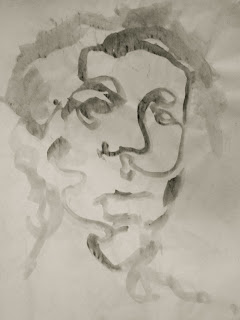


November 2008.
 The testing process produces a large amount of waste material, as often several pieces of photo paper may be necessary to determine the proper exposure. This is where things can get interesting. Often test prints are not fully developed and are generally discarded after brief examination, allowing for strange things to happen chemically on the print.
The testing process produces a large amount of waste material, as often several pieces of photo paper may be necessary to determine the proper exposure. This is where things can get interesting. Often test prints are not fully developed and are generally discarded after brief examination, allowing for strange things to happen chemically on the print. This print was not floated properly in the developing bath, and as you can see, the paper failed to come in uniform contact with the chemicals and developed at several different rates.
This print was not floated properly in the developing bath, and as you can see, the paper failed to come in uniform contact with the chemicals and developed at several different rates. Another strange thing that happens: this print was neither placed into a stop bath or fixer before discarded, meaning that after being thrown away, developing continued to occur. The print has brown chemical stains on it from being exposed to light in the darkroom.
Another strange thing that happens: this print was neither placed into a stop bath or fixer before discarded, meaning that after being thrown away, developing continued to occur. The print has brown chemical stains on it from being exposed to light in the darkroom.






 The decaying property was purchased from the state of Rhode Island in 2005 by Carpionato Properties, a developer based in Cranston, with the promise of restoring the architectural integrity of the building and developing it for new public use. Despite their seemingly good intentions, Carpionato sat on this promise until 2008, when the security of the building had been breached and the structure had fallen into such great decay a Providence Building Official ordered Carpionato to acquire a demolition permit, citing the safety of the residents of 403 apartments across the street as a concern.
The decaying property was purchased from the state of Rhode Island in 2005 by Carpionato Properties, a developer based in Cranston, with the promise of restoring the architectural integrity of the building and developing it for new public use. Despite their seemingly good intentions, Carpionato sat on this promise until 2008, when the security of the building had been breached and the structure had fallen into such great decay a Providence Building Official ordered Carpionato to acquire a demolition permit, citing the safety of the residents of 403 apartments across the street as a concern.






 Gelatin silver prints, 2008
Gelatin silver prints, 2008








